The following article by Len Stillwell
first appeared nearly ten years ago in issue number 29 of our
Form 700 Regional Newsletter, and tells the story of a young
man's ambition to fly, his operational training, and of service
life on an RAF Squadron overseas during the war. It is now
reproduced below, in full, and we do hope that you enjoy the
following piece as much as we enjoyed rereading it.
For many people the training route to
becoming a pilot was much the same, and so this story will
hopefully bring back fond memories, and for those of us too
young to have served during the war, it provides a wonderful
insight for which we owe our thanks to Len.
Len flew Spitfire Mks VIII
and IX, with their distinctive white flash on the fin, over
Italy and Austria, with the famed Battle of Britain Squadron,
no. 92. What Len does not mention here is that whilst on a sweep
over Italy his Spitfire was hit by an anti-aircraft shell
severely wounding him in both legs; an injury which always
remained with him. In spite of this, Len was back flying
again after a short R&R break.
Sadly, during a spell in hospital, Len
Stillwell died in early December 2008.
We feel that the following article is a
fitting memorial to our dear friend; an obituary will appear in
the next Form 700 Newsletter.
Len served on the Eastern Region Committee
for many years right up until the last months of his life and
was always pleased to help younger Committee Members with
valuable words of advice and wisdom.
In June of 2008, Len’s wife Dorothy (or Dot
to all who knew her) died after bravely battling illness for
some years, during which time Len was her pillar of strength.
Since the early days of Eastern Region, Len and Dot were always
a familiar sight at Society events and air shows and in common
with our other ‘Regulars’ have helped to raise many thousands of
pounds for the Spitfire Society.
Len and Dot were two of the most loved
members of our team and always represented that which is best
about the Spitfire Society.
P.W. December 2008
--------------
Becoming a fighter pilot is
not and never has been easy - even with the urgency and impetus
of war. We all are, at times, beneficiaries of luck or good
fortune in whatever we undertake and I certainly had my fair
share of both - I hope this story will show that, but I must
explain that it will say very little about my combat experience.
More, perhaps about the journey I undertook (in common with so
many) and the things that happened along the way.
L.S. June 1999
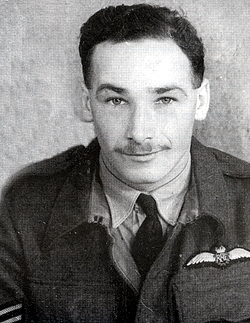
DREAMS OF FLYING
As a child in the early
'thirties I dreamed of flying and piloting a plane and my father
took me on two occasions to the Hendon Air Display. I thrilled
to see wonderful biplanes such as the Bulldog and Fury perform
aerobatics in neat formations and joined together by coloured
tapes.
My first experience of flight
was at Blackheath in South London. Alan Cobham's Flying Circus
was on the Heath and my sister and I took joyrides in a large
twin engined biplane. I was a boy scout and longed to join an
air scout troop, but they were few in number then.
In 1938 the Air League formed
the Air Defence Cadet Corps, which was more to my taste. Our
uniform was based upon that of the RAF and we attended parades
and lectures given by RAF personnel and visited local RAF
Stations. It was at RAF Biggin Hill that I remember first seeing
the new Hurricane fighter.
War came in 1939 and I was at
school in London. I tried to join the Auxiliary Fire Service but
was rejected as being too young. I did, however, during the
Blitz, drive a mobile canteen around Air Raid Shelters when no
other driver was available.
JOINING THE AIR TRAINING CORPS
Then the Air Training Corps
was formed from the nucleus of the ADCC and I immediately joined
the local squadron.
Training and instruction in
many disciplines was more professional and examinations for
Proficiency Awards were held. Many weekends were spent at RAF
Balloon Command HQ at Kidbrooke, where cadets helped out with
many non technical tasks. I spent much of my time in the Signals
section where messages and orders were received and passed on to
Balloon sites.
The visits I enjoyed most were
the annual camps in 1941 and 42 at RAF Biggin Hill. It was here
that I had a flight in a Magister and the pilot allowed me my
first hands on experience of flying. I also sat in a Spitfire
while a fitter leaned into the cockpit and started the engine -
a great thrill.
At the age of 17 I volunteered
for air crew training. At that time you could not apply for
pilot training only but had to apply for the group which
included pilot, navigator and bomb aimer (known as PNB). Your
suitability for your eventual trade was supposed to be
determined by aptitude during your training period.
We had Aldis lamp practice in a local park and
range shooting with rifle, revolver and sten gun. Clay pigeon
shooting also featured heavily in the syllabus. Vigorous
physical training was interspersed with long cross country runs
up and down the local hills and we played inter flight rugby. At
the end of the course we went on leave a bit wiser and a lot
fitter.
HOSPITAL ATTACK
Whilst on leave, I became
unwell and on my return I reported sick. I was sent to the sick
bay which was located in a local hotel, which had been
requisitioned by the RAF as a hospital and convalescent centre.
As I sat in bed, one Sunday afternoon, looking out to sea, I
noticed three low flying aircraft heading for the shore. I felt
sure they were friendly, when suddenly every anti aircraft gun
in the area opened up. They turned out to be Me109f's.
In spite of big red crosses
prominently painted on the roof of the hotel, they bombed and
strafed the building, killing and wounding many of the
occupants. We later learned that they had earlier attacked the
local district of St Marychurch and scored direct hits on a
church hall full of children. Many were killed.
GRADING SCHOOL
On being passed fit for duty I
returned to the ITW and having passed the course, was posted to
Grading School at Theale near Reading. This was where my
aptitude as a pilot would be assessed. I carried out 12 hours
dual instruction on Tiger Moths where all the basic manoeuvres
of climbing, turning, spinning, stalling and descending were
taught and examined. Twelve hours in a real aeroplane - I just
had to pass!
We also had to take turns on
night guard duty as well as setting out the flare path when the
instructors were night flying. A dash of rum in the hot strong
cocoa helped to wash down the doorstep bully beef sandwiches.
The completion of the course
saw us sent home on embarkation leave. Saying goodbye to family
and friends without the slightest knowledge of where you are
going or how long you are likely to be away is not easy, so it
was with some trepidation that I left home for Heaton Park,
Manchester, just hoping I had made the pilot grade. Four of us
were billeted together in a house at Salford. Our days were
spent rather aimlessly at Heaton Park, our weekends mainly in a
YMCA canteen in Piccadilly, Manchester.
RHODESIA BOUND
After three weeks we were
paraded and given our grades. I was selected for pilot training
and posted in a draft bound for Southern Rhodesia. We were sworn
to secrecy and then issued with tropical kit and subjected to
numerous inoculations. Very early one morning we piled into
trucks and were taken to the railway station where we caught a
packed troop train for Glasgow. After many hours we arrived at
Gourock on the Clyde and were transported by tender to our new
home - a converted cargo liner, the 'Llangibby Castle', which
was dwarfed by the presence of the 'Queen Mary'.
Crammed into the lower decks
with several hundred men, we were shown how to stow our kit and
provided with hammocks and life jackets. Once on, I don't think
we took the latter off, even when sleeping, fully clothed.
Conditions were grim and
became even worse when we ran into bad weather. Battened down
below we were violently sea sick and the constant rolling and
pitching of the ship sent the buckets provided sliding all over
the wet floor. No one could eat and we fervently prayed that
there were no U Boats in our area.
As the gale subsided we were
allowed on deck for brief periods and we could see the other
ships in the convoy and our escorting aircraft carrier and
accompanying naval vessels. Despite the heavy seas, the carrier
flew off several Swordfish and we watched one miss the arrester
wire as it landed and it bounced off the flight deck into the
sea. No rescue was attempted.
We had little to do, other
than write letters which were heavily censored and wait
hopefully for our ship to reach a port. Our hopes were cruelly
dashed. Our ship was suddenly diverted from its course down the
west coast of Africa into the Mediterranean -without even
stopping at Gibraltar. All available transport was needed for
the invasion of Sicily and we were joined by numerous other
transports and warships.
Along with the others our ship
was heavily armed and frequently we were herded below when at
Action Stations and heard and felt our guns firing. No damage
occurred and the only aircraft we saw were American P38
Lightnings. After several days of this we arrived at Port Taufiq
at the southern end of the Suez canal, where we disembarked. The
first part of our voyage was thankfully over.
CAMELS AND SCORPIONS
We were sent to a transit camp
where we slept under canvas and were plagued by flies and the
intense heat. Water was issued once a day and the food was of
doubtful quality - dry bread, margarine and cooked meat, which
the cooks assured us was stewed camel.
Toilets were just pits with
multi holed seating, but our one luxury was a communal shower.
We were marched for about an hour to the ablution area and then
stood around awaiting our turn. Water was delivered to this
point in pipes laid under the sand, so was reasonably hot.
Eventually we were marched into a canvas screened area, stripped
off and walked on duckboards under pipes gushing water. What
bliss to be clean again.
The unbearably hot day was in
sharp contrast with the bitterly cold night and our single
blanket did little to keep us warm. Very soon many of us were
suffering from dysentery because of the conditions and I
suffered a scorpion bite to the throat and was dispatched back
to base hospital. By the time I had recovered, my draft had
moved on, so I had to wait for another ship to take me on to
Durban.
Joining the 'Empire Trooper' I
found it contained mainly South African troops, but there were a
few RAF trainees aboard and it was here that I met Dennis
Richardson, who was to become a very close friend during our
service together and later into civilian life.
As we sailed down the east
coast of Africa the stifling heat forced us to sleep on deck and
it was a great relief to enter Durban harbour. We were greeted
by the sound of a wonderful female soprano voice and were
astonished to see a lady dressed in white and wearing a broad
brimmed red hat singing unaccompanied to the convoy as it sailed
in. 'Land of Hope and Glory', 'Roll out the Barrel' and many
other favourites were delivered across the still water.
I later found out that her
name was Perla Siedle Gibson and from 1940 until 1945 she
provided this unique welcome to many thousands of service
personnel who arrived in Durban this way.
ARRIVAL IN RHODESIA
We spent a short time in
Claremont Transit camp and then joined a very long train for the
journey through the magnificent scenery of the Drakensberg
Mountains and past Lady smith. After two nights on the train we
arrived at Bulawayo, Southern Rhodesia and were sent to Hillside
Camp - a former cattle market - where we were billeted in the
former cattle stalls. I spent Christmas 1943 at Hillside, having
Christmas dinner served to us by the officers.
We were given a further ground
course at Hillside ITW and then posted to No.25 Elementary
Flying Training School (EFTS) at Belvedere, near Salisbury. We
trained on Cornell PT26's and our training was often interrupted
by the flooding of the airfield, during the rainy season. I
remember being caught by a massive thunderstorm, whilst flying
dual and we were forced to land at a tiny satellite field and
take shelter in a thatched hut. A field telephone link told us
when it was safe to return.
At the completion of our EFTS
course Dennis and I were selected for single engine aircraft.
Those selected for twin engine training left us to go their separate ways. We
moved across Salisbury to No. 20 Service Flying Training School
(SFTS) at RAF Cranborne, where we flew Harvards.
Cranborne was an airfield with
a hump in the runway - much like Biggin Hill. During take off
you could not see the far side of the field until you had topped
the rise, so both take offs and landings were fairly
interesting.
Living accommodation at SFTS
was very much better and we had the use of the sergeant's mess.
Our training now included sessions in the Link Trainer learning
instrument flying and ground controlled approach as well as
numerous cross country flights by day and by night.
One moment of light relief was the making of a
film by the Ministry of Information about the contribution that
Rhodesia made to the Empire Air Training Scheme. We were posed
in groups around aircraft listening to instructors and filmed
climbing in and out of the cockpit, as well as taxiing along the
runway. The climax of this film was a mass formation of Harvards
(all flown by instructors). Every serviceable aircraft took part
and most impressive it was to watch.
Flying finished at noon on
Saturday and we were free to spend the remainder of the weekend
in Salisbury. We stayed at the Troops Hostel and swam in the
open air pool. We also got to know some local families who
offered us friendship and hospitality, which was much appreciated. Much of our
time was spent at the cinema, where we avidly watched newsreels
of the progress of the war.
GETTING MY WINGS
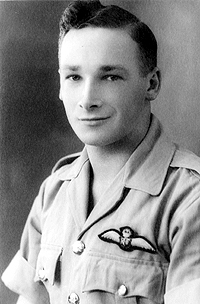
My time at SFTS was drawing to
a close and examinations and final air tests by the CFI led to
qualification as a service pilot. A few of our mob failed and we
didn't see them again as they were sent off to remuster. The day
of the Wings Parade came and we made commendable efforts to look
smart and tidy as we received our Wings.
Following the parade we
returned to our billets to find the next draft of sprog pilots
moving in. Leave followed, and my friend Dennis Richardson and I
caught the train to Livingstone and went to see the Victoria
Falls.
EGYPT POSTING
Returning from leave we
received our postings. Ten of us (Dennis included) were posted
to an OTU in Egypt. We left Cranborne in a Lockheed Lodestar (in
BOAC markings) for Kano in Nigeria and the following day flew on
to Khartoum in the Sudan. The final leg of our journey took us
to Cairo where we were billeted in the Heliopolis Palace Hotel.
We spent some time in Cairo, enjoying ourselves in the French
quarter and guarding our belongings from the skill of the
fellaheen who could divest an unwary victim of anything without
being detected.
FIRST SPITFIRE FLIGHT
Our period of luxurious living
ended when we were moved to a tented transit camp and subjected
to numerous fierce sand storms. From here we eventually
travelled to 71 OTU at Ismailia in the Canal Zone. Here we flew
Hurricanes and it was on 15th January 1945 that I achieved my
ambition when I flew my first Spitfire - Mark V EP708. I cannot
remember my feelings at the time, but it seemed a significant
milestone in my career.
At the end of our course we
went on a further period of leave and managed a trip from Cairo
to Jerusalem (a train journey I wouldn't want to repeat). The
Holy Land was slightly disappointing and it even snowed when we
were in Bethlehem.
We left Egypt by Dakota for
Rome, via Malta, and on arrival I was posted to a Refresher
Flying Unit (RFU) where I converted to Mark IX Spitfires. Our
runway was a section of a straight tree lined road, which was
heavily cambered. Take offs and landings in the much heavier and
more powerful Spitfire were quite hair raising at times.
We flew and practiced battle
formations and at the end of the course I was officially a
fighter pilot, although I didn't feel like it at the time and
realised that I had a lot to learn.
92 SQUADRON
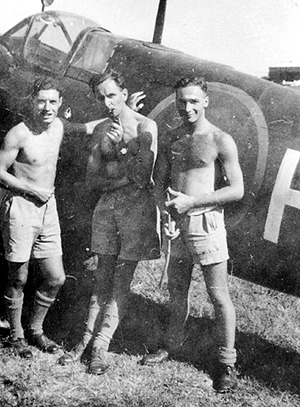
From the RFU I was posted to
92 Squadron, part of 244 Wing. This was a fighter/bomber
squadron and our principal task was close ground support of our
forward troops. All the squadrons on the Wing had to be totally
mobile in order to keep up with the rapidly changing situation.
This meant that everything that was necessary to support
operations had to be capable of being packed into a lorry or on
a trailer. Even unserviceable aircraft were moved on 'Queen
Mary' low loaders.
Ground conditions varied
enormously and we relied on the Royal Engineers Airfield
Construction Units to move forward - often under fire - and lay
Pierced Steel Planking (PSP) for runways. Landings had to be
very precise because if you ran off the end or sides the
aircraft might easily tip over or end up in a quagmire.
Personnel were billeted under canvas or in whatever buildings
were close at hand. The quality of the food we ate varied
enormously, but a resourceful Mess sergeant could very often
conjure up fresh meat and vegetables instead of the dreary and
unappetising tinned M & V, bully or baked beans.
The intense heat found us
wearing nothing but shorts, except when we flew. Then long
sleeve shirts and trousers were the order of the day. The longer
our aircraft stood in the sun, the hotter they became and it was
necessary to wear gloves, even to touch them. Sitting in the
cockpit at readiness or waiting engine start up wearing helmet,
Mae West, parachute and tightly strapped in with the Sutton
harness was absolute agony. How we longed for the fan to start
turning. Once the engine was running, we got off as quickly as
possible to avoid overheating in such temperatures.
Things were so different in
the winter and the rainy season. The rains seemed to last for
weeks on end and what had been fine, choking dust became thick
squelching mud.
Getting around was impossible
and we rarely took off our flying boots - except when we flew
that is, as they were never worn for that purpose. Our clothes
were permanently damp and it was also exceptionally cold. If we
managed to find a relatively undamaged building to live in, we
relied on our ground crew to rig up a rather dangerous drip feed
heater, which used petrol or kerosene. The fumes were dreadful
but the cold was even worse.
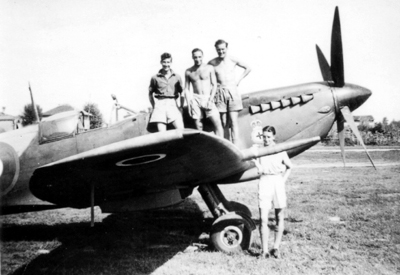
AFTER THE WAR
The end of the European war
found me in a field hospital, recovering from wounds inflicted
by flak. When I returned to the Squadron there was speculation
that we might be shipped off to the Far East to fight the
Japanese and we were glad when that conflict also ended.
From Bellaria we moved further
north to Treviso and the Wing was stood down for a month. We
relaxed in rest camps set up in
Venice and Cortina and skiing
became quite popular. Our mobility was curtailed, however, when
the German and Italian Army vehicles we had 'liberated' were all
confiscated.
One notable memory that I have
of that time was the Open Day that we organised for the local
population. We set up marquees and the cooks excelled themselves
by producing large quantities of sandwiches, cakes and jellies.
Within an hour of hundreds of local people and children arriving
the whole lot had gone - hardly surprising in the circumstances.
The good times did not last
long as we were moved to Zeltwig in Austria. There was tension
between the Allies and Marshal Tito, who had taken power in
Yugoslavia, over disputed Italian territory. The Wing was put on
stand by in case of trouble. Our base was a former Luftwaffe
airfield and there was a huge pile of wrecked German aircraft on
the dump. We were billeted in wooden huts and conditions were
tolerable in summer as we were about 5,000 feet up a mountain
valley.
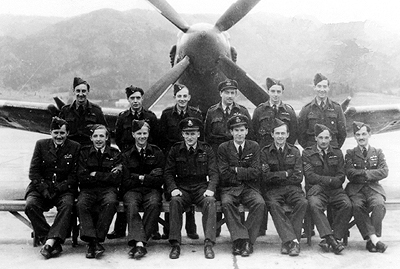
The winter was bitterly cold
and flying became difficult and dangerous. Constant snow
clearing of the runway was necessary and life seemed to be one
long working party. Thick snow in the mountains cut us off from
our supply base and we were reduced to very basic rations,
although we did manage to supplement these with some game birds
that we shot and scrounged turnips and potatoes.
Because of the Tito emergency
our tour expired and demobilisation leave was suspended and this
caused a great deal of anger and resentment, especially with
those who had many years service. An officer of Air Rank was
flown in to try and reduce the tension and we were all paraded
to be told that the situation would soon be resolved, but in the
meantime the Riot Act would be formally read to us. This having
been done the top brass smartly disappeared. Fortunately the
situation was stabilised shortly afterwards.
BACK TO HOME
Some six weeks later I left
the Squadron for the UK. We travelled by train from Klagenfurt
to Calais in an unheated baggage truck, riding on top of wooden
boxes. We stopped every few hours when food was dispensed and
after two days arrived at Calais. The crossing to Dover was very
rough but we came on deck to see the White Cliffs through the
mist. After a short journey to Shorncliffe Camp we caught trains
for home.
It was good to be home again
after three years away from England. To swop experiences with
friends and family and to try and settle back into some sort of
normality. I was posted to RAF Oxbridge where I did nothing
except report every morning and then return home.
When my demob number came up I
travelled to Preston and was demobilised. My wartime service as
an RAF Fighter Pilot was over. When I look back I realise that
although I had to endure difficult and sometimes dangerous
conditions, the situation was just as bad, if not worse for many
of those who had to stay and continue to work at home.
We were all in the war
together and this is just one tiny, insignificant story of life
in those times.
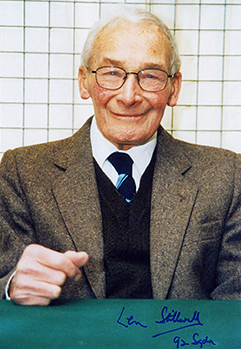
You might like to know that signed drawings /
photos of Len and his aircraft are available from the Spitfire
Society. You can find further details here:

The Spitfire Society Interview with Alex Henshaw can be found here:

& previous interviews with Bert Harman:

& Audrey Morgan:



